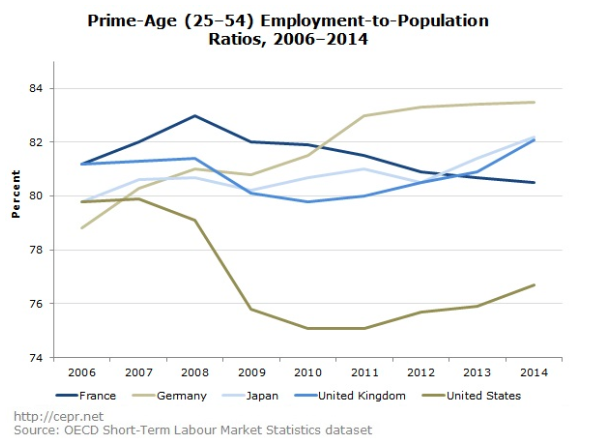It seems almost ungrateful to complain about the announcement that the U.S. added 223,000 jobs to the economy in April, dropping the official unemployment rate to 5.4 percent, particularly after the dismal showing in March. Economists saw those numbers as reason for a “sigh of relief,” as one put it. But the truth is that for many American workers, the jobs recovery hasn’t yet provided real relief — and there is still a lot of ground to cover before the country can be said to have truly recovered the losses from the Great Recession.
The labor force participation rate remains considerably lower than it was prior to the recession, and while that has something to do with baby boomers retiring, the demographic changes don’t account for everything. As this chart from the left-leaning Economic Policy Institute in Washington shows, there are still fewer Americans of prime working age in the labor force now, on a percentage basis, than there were at the start of the recession.
Related: 7 Quirky Economic Indicators – from Dogs to Guns

Economist Jared Bernstein, a senior fellow at the Center on Budget and Policy Priorities, writes that the labor force participation rate, now at 62.8 percent, appears to have stabilized in the neighborhood of 63 percent. Factoring in a growing population, that flattening out could be seen as a positive.
“That’s better than a declining rate—at least some of the decline was driven by labor-force leavers discouraged by their job prospects,” he writes. “But most analysts, myself included, believe there’s considerably room for the lfpr to tick up as labor demand returns. The reason this matters—why it’s actually a big deal—is that this dynamic means there’s more slack in the job market than the relatively low unemployment rate suggests.”
Interestingly, the U.S. remains dramatically below other developed countries in the employment level of prime-working-age people, including countries that failed to weather the recession as well as the U.S. “The United States is doing far worse in employing prime age workers than its competitors,” said economist Dean Baker of the progressive Center for Economic and Policy Research.

And, as has become her habit on jobs day each month, EPI economist Elise Gould points out that we can take only so much comfort in the fact that the economy has trundled its way back to the same absolute number of jobs it has prior to the recession. That’s because population growth means we need millions more jobs to make up for the growth in working age population since then.
Related: What First Quarter Earnings Reveal About the State of Corporate America
We need to add more than 3 million jobs before we return to pre-recession labor market health, such as it was. pic.twitter.com/ilzfOJjfRp
— Elise Gould (@eliselgould) May 8, 2015
Another concern in the report is the continued anemic pace of wage growth. Pay levels ticked up just 0.1 percent in April, which suggests that employers are not feeling pressure to hike wages. That pressure usually only manifests when workers feel confident that there are other jobs out there waiting for them.
House Speaker John Boehner (R-OH) addressed the report with a statement pointing out its shortcomings. “While the economy continues to show some signs of improvement, too many middle-class families are struggling just to get by. Too many Americans remain out of work, and too many are working harder only to lose ground to stagnant wages and rising costs. We can do better.”
On that point, economists on the left wholeheartedly agree.
Top Reads from The Fiscal Times:




